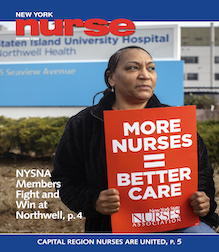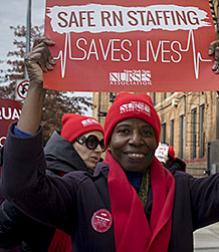A hospital can be a very dangerous place to work.
According to the U.S. Department of Labor, nurses in acute and long-term care facilities experience rates of non-fatal workplace assault double that of workers in other healthcare settings and ten times that of workers in the private sector overall. Moreover, the DOL suggests that healthcare workplace violence is vastly underreported. The government formally collects only incidents that lead to time away from work. Surveys show that many incidents go unreported, even at facilities with formal incident reporting systems.
And while it is a common perception that hospital workplace assaults are limited to psychiatric units, the reality is that an increasing share of incidents occurs across many other departments as well. Just ask the NYSNA nurse at Wyckoff Heights Medical Center’s Emergency Department who earlier this year had hot tea thrown in her face by the daughter of a patient who had fallen and she was helping to stand. Or ask the Mount Sinai rehab nurse whom a patient’s relatives attacked as she tried to protect a baby in the midst of a family dispute. These are just two of the far too many examples of assaults against NYSNA members that took place in 2016.
Many contributing factors
Patients with co-morbidities — i.e. both mental and physical health issues — are often treated on med/surg or other units where specially trained mental health staff is not available.
Other factors that can increase the risk of assault include poor staffing: fewer bedside staff taking care of more patients heightens risks; long patient wait times or delays can lead to increased anger by both patients and visitors; and overcrowding in emergency rooms or other units leads to increased tensions.
More liberal visitation policies are another concern. Under pressure to improve patient satisfaction scores, many hospitals have adopted an open door, 24-7 policy. “It’s a free for all,” said one SIUH nurse, where the open door policy is an issue on a range of units. When a patient has visitors around the clock, sometimes in large groups, it can be difficult for staff to do their jobs performing patient care tasks. It is typically left to the unit nursing staff to insist that visitors leave, which sometimes results in angry, hostile confrontations.
Assault takes many forms
Government data show the most common causes of violence-induced injuries resulting in days away from work across several healthcare occupations were hitting, kicking, beating, and/or shoving. But emotional trauma is even more prevalent.
While staffing, changing demographics and other issues need to be addressed to reduce the risk of assault, we also need to take on the misconception that getting hit or spit on is “just part of the job.” Nurses continue to hear this response too often from hospital management and even security and police when they respond to incidents.
Another misconception surrounds the New York State law that charges those who assault nurses with a felony. It is unlikely that the law will deter a patient who is mentally ill, drug seeking or under the influence of drugs or alcohol from assaulting a nurse. And, unfortunately, the experience to date has shown that it is extremely difficult to secure a felony charge, let alone a conviction, against a patient, even if the assault meets the requirements of the law.
Such was the experience of two NYSNA nurses at Staten Island University Hospital. One nurse was punched in the face while working in the ER triage area. Another was bitten by a patient on a med/surg floor. Both filed felony assault charges. In both cases the district attorney refused to advance the felony charges, reducing them to misdemeanors.
While it is important to keep pressuring police and district attorneys to uphold the law, prevention is likely to be most effective in reducing assaults. The risk of assault can be assessed and reduced, just as with any other safety hazard (see below).
Public sector law
NYSNA and other New York unions fought to win a state-wide law that focuses on prevention of violence in the workplace. Passed in 2009, the law fell short in some areas and covers only public sector employers. However, it still has key provisions that all workplaces should adopt. By law, public sector employers must:
- Work with unions to identify potential workplace violence hazards in their workplaces;
- Implement controls to limit the risks of identified hazards;
- Adopt workplace violence policies that will decrease the risk of violence; and
- Maintain and review all records related to workplace violence incidents.
- Whether public or private sector, input from frontline staff is key to the development and implementation of an effective workplace violence prevention program. Winning and enforcing these kinds of protections takes work but will pay off in reduced assaults and injuries to nurses. There are steps every workplace should take to decrease the risks and incidence of violence (see Sidebar). And, of course, NYSNA’s Occupational Safety and Health Department is available to assist members seeking to improve their facility’s violence prevention programs.




